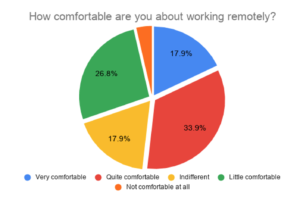
Written by Jacopo Lazzarin
Abstract
The Covid pandemic has contributed to make remote working the ‘new normal’ across the globe. We have understood that the workplace is evolving and, as a consequence, we have to embrace and recognize this evolution. In particular, it is crucial to assess the impact of remote working on young people, which has both positive and negative aspects. In doing so, it is fundamental to tackle the issues linked to remote working and to promote the opportunities that come with it. The objective of this paper is that of increasing awareness and shedding light on the consequences of remote working. The methodology used is that of direct and indirect data collection. The former involves the creation and distribution of a survey to collect young people’s opinion. The latter involves extensive research of available information on remote work.
Introduction
The consequences of the Covid-19 pandemic are multifold and some will be long-lasting. During the first months of this health emergency, a new world has arisen. This paper will focus on the consequences – both issues and opportunities – of virtual work and will try, specifically, to assess its impact on youth (18-30 years old). As a starting point, it is necessary to clarify the huge dimensions that virtual work has gained. Such a phenomenon has forcibly become popular during the first months of 2020 because of the impossibility to work from offices. Even though such practice was not new “only 5.4% of employed in the EU-27 usually worked from home”[1] in 2019 but by the time full measures to contrast the spread of the virus were put in place such percentage raised to 40%.[2] However, the crucial aspect of virtual work is that it is here to stay. Several firms will rethink the way their employees will work, and being physically in the office will not be so common as it used to be before the beginning of the pandemic. From this point of view, Covid-19 has simply accelerated a process that was already taking place. This paper is divided into 6 sessions, each analysing a specific topic related to virtual work. The objective is that of giving an overview of what remote work is and its effect on youth.
General problems related to virtual work
To start with, it is useful to look at the general problems associated with remote work. As this is not a new way of working its impacts have already been analysed and there are some familiar trends virtual workers go through. In a pre-pandemic survey, the main struggles of remote working were the difficulty to unplug after work, the experience of loneliness and an obstacle to communication.[3] These issues can be detrimental and extremely stressful in the long term and shall be taken into consideration when advocating for more e-work. This is particularly true because virtual workers have a high risk of working longer hours and seeing the boundaries between work and personal life blurred.[4] Moreover, people working from home report a greater level of difficulties in solving problems that may arise with their colleagues[5] thus improving stress and a sense of distancing from their team. Being physically far might translate into being psychologically far as well as being perceived so. These are the main issues of working remotely and shall not be underestimated when assessing telework’s efficiency.
General opportunities related to virtual work
However, we may not neglect the opportunities that virtual work offers. As there are some negative aspects there are also several beneficial consequences of working remotely. And this is why more and more employees had been taking advantage of such work practice when available – well before the world knew Covid-19. According to Forbes,[6] which conducted an analysis of the world-leading research institutions’ data on telework, there are five proven benefits of working remotely: an increase in productivity (35-40% more productive than office counterparts), an increase in the quality of work (40% fewer quality defects), a higher engagement due to the first two points (41% lower absenteeism), a smaller amounts of turnovers (12% reduction) and increased profitability for the firm (21% higher profitability). As it is evident, these qualities of virtual work demonstrate how it represents a great opportunity both for employees and for firms. At the same time, as it is clear from the previous paragraph, there are still several adjustments companies have to make before telework may become completely effective in creating an ideal work environment.
Virtual work during the pandemic
Now it is time to analyse the situation of virtual work during the current pandemic. Ais expected, a huge amount of people started to work remotely since the beginning of the health emergency. In a survey conducted by Gartner Inc.,[7] by March the 17th, 88% of companies globally asked or required their workforce to work remotely. This is an impressive number and shows how millions of people and thousands of companies had to shift to virtual work in a matter of days – if not hours. In the following months the trend of working virtually continued and trying to reverse it has not been easy. To explain why it is worthwhile to take into consideration the emblematic case of the UK where companies had initially been forced to shut their offices but were later asked to bring their employees back to daily commuting. Foreign Secretary Dominic Raab declared that “the economy needs to have people back at work”,[8] however, employees and firms have been reluctant to return to office work and 9 out of 10 workers plan to keep working from home. The reasons for employees and firms’ reluctance to go back to office work was that the spread of the virus had not stopped, therefore mining the safety of daily commutes. Moreover, adapting offices to social distancing could require difficulties on the employers’ side and, most importantly – as outlined in paragraph 3 – employees may not be so willing to go back to work as they used to. All these factors led to empty offices in London as well as in other major cities, further impacting the economy.[9] For instance, 57 out of 264 shops in Oxford Street, London are already permanently closed as of February 2021.[10] In other countries, the situation has not been dramatically different. Virtual work has been very common in the last months and has remained a normal practice even in the summer months which were not too badly affected by the virus.
Prospects of virtual work after the pandemic
What are the future perspectives of virtual work? After the pandemic will be over – or at least under control – what will be the place of remote working? The answer is that it is here to stay. Even though the slow shift to more working from home started well before the Covid-19 era, this health emergency stimulated a faster transition to telework. It is highly likely that several firms will permanently switch to partial or complete virtual work routine within the next few years. Some big tech giants such as Microsoft and Facebook have already announced their intentions to move to remote work permanently.[11] Virtual work is going to become the new reality through which our society will approach working. This does not mean there will be no offices at all or that commuting is something that belongs to the past for white-collar jobs. It means that employees will generally have a chance to decide whether they prefer to work from home or from the office. And, at the same time, it will mean firms may not need to pay for big office spaces anymore. However the future might develop, virtual work is and will be a common reality.
How young people dealt with virtual working
We will now look at how young people reacted to a virtual working environment. In particular, we are interested in understanding how starting a new career or developing one has been affected by virtual work. Before focusing on this, it is helpful to hint at what the big picture looks like for younger generations. Unfortunately, it is not a positive one. Young people are having serious difficulty in securing a job and their unemployment rate is far higher than that of their older counterparts. Looking at figures for the EU in October 20 20, we can see that youth unemployment stands at 17.5% as opposed to 7.6% of unemployment for adults.[12] Teens, for example, experienced a rate that was more than twice the national average.[13] And recent graduates have been affected in a similar way. A BBC article analysed how a “Research by UK-based graduate jobs website Milkround shows just 18% of graduates are securing jobs this year compared to the typical 60%.”[14] All these data lead to the fact that young people are entering a job market that is very unfavourable. On top of this, those who were fortunate to find a job or who already had one and were able to keep it had to face a totally different work environment. In a survey[15] conducted by Smartsheet in April, it is clear that Gen Z (10-24 years old) is experiencing more problems due to virtual work than older generations. Where three-fourths of the American workforce feels less connected, this percentage goes up to 82% when we consider those born after 1996. The same applies when we look at how less informed American workers feel. For instance, 74% of Gen Z report feeling less informed as opposed to 50% of Boomers saying so. Another BBC article[16] shows how hard it can be for the younger generation to build a network and feel part of their team. These facts could point to the conclusion that the higher difficulties shown by younger generations have to do with their not yet being an integral part of the companies. This could be mainly due to the fact that they are completely new or have been working there for relatively little time. On the other hand, young employees have also been able to recognize the opportunity given by not having to move to big cities and, therefore, saving some money on their rents.[17] Furthermore, new jobs tend to be more oriented towards more and more remote working, thus making such opportunities available to more people across different geographical locations, as in the case of the US states.[18]
Young people’s perspectives and expectations for the future of virtual work
We have seen and analysed how young people reacted to the new working environment that came into place following the current emergency. We shall now look at what are the perspectives for the future of blended and virtual working over the next few years. In order to get some fresh data, it has been useful to create a specific survey on the matter that was distributed among young people across Europe. This survey has been drafted and construed within the EST Youth Employment Working Group. The methodology adopted has been that of multiple-choice questions that allowed either one or, in some cases, more than one answers. Once created the survey has been rolled out through private and EST networks. The goal of such a survey was that of developing peculiar questions that addressed topics around remote work and that would have been answered by those around whom this research is focused, that is, young people. We have obtained some interesting insights that overall show a positive attitude towards virtual working.
The two graphs show the answer to some of the questions of the survey. It is of impact to see how 0% of participants expressed a totally negative view on working in a company that promotes blended working (there was, in fact, a fifth alternative possible: “absolutely not”). And an overwhelming majority of 85.7% expressed a positive or very positive opinion of blended working. These results show how young people want to be part of an organization that gives them the possibility of working both in the office and at home. These reasons are to be found in all the opportunities of remote working that we analyzed in previous sections of this research.
Another important result obtained from this survey is that the majority of participants (51,8%) already feel comfortable about working remotely, which shows a positive attitude towards the idea of working virtually.
Furthermore, when asked whether remote working is seen as an opportunity or an issue 82,1% responded that it was more an opportunity than an issue. This result points even more to the fact that young generations are likely to look positively to virtual working.
This survey has been helpful to outline how remote work is perceived by younger generations and, as the results show, we can say young people have a positive attitude towards it.
What next?
This paper has outlined how telework is a way of working that was widely spread well before the Covid-19 pandemic but that has now become fully integrated into the ‘new norm’. Whether we like it or not it is here to stay and it will become more and more normal to be working from our homes, from our local libraries and parks. Firms will promote blended working solutions for most, or all, of their employees. The whole world will see daily commuting as something that belongs to the past. This aspect is even more relevant for young people who are starting a career now and will never know what the working environment used to look like. As has been outlined in previous sections of this article, working remotely is perceived positively even though there are some serious and evident issues that are to be addressed. In particular, it would be crucial to make sure that a good working life is guaranteed to all employees. This means making sure everyone feels part of the team and can connect and network with others. Solutions should be put in place to minimize isolation and stress related to lack of human contact.
In the survey participants were also asked to indicate which strategies could be adopted by companies in order to make remote workers feel part of the firm from the very beginning (they could select more than one). 64,3% of participants said that having “several meetings and calls with new colleagues to get to know each other and build relationships” would be a good solution to be implemented. Another popular response (55,4%) was that of having “a few guided introductory days to get confident with the environment”. These results are also in line with addressing what we have analysed as being some of the biggest issues of remote working. In conclusion, we should all be aware of the opportunities of remote working as well as of its issues. Therefore, we should try to solve such problems to make the best out of this new common reality, thus leading to benefits for employees and for firms.
In order to do so, it is important to adopt common EU rules that favour the integration of employees within firms. At the same time, it is important to make sure that work from home is considered on the same level as work in the office. It is also crucial to invest in the mental and physical health of people. In particular, there should be discussions undertaken at a European level on what psychological consequences telework produces and how to best tackle the negative ones. Finally, it is important to keep researching the impact and evolution of remote working to improve our understanding of it and to help policy-makers make more informed and pertinent decisions.
Reference List
BBC, 2020, Microsoft makes remote work option permanent, https://www.bbc.com/news/business-54482245.
Buffer, 2019, State of Remote Work, https://buffer.com/state-of-remote-work-2019.
Christine A. Grant and Louise Margaret Wallace and Peter Spurgeon, 2013, An exploration of the psychological factors affecting remote e-worker’s job effectiveness, well-being and work-life balance, https://www.researchgate.net/publication/281035493_An_exploration_of_the_psychological_factors_affecting_remote_e-worker’s_job_effectiveness_well-being_and_work-life_balance.
European Commission, 2020, Telework in the EU before and after the COVID-19: where we were, where we head to, https://ec.europa.eu/jrc/sites/jrcsh/files/jrc120945_policy_brief_-_covid_and_telework_final.pdf.
Eurostat, 2020, Newsrelease euroindicators, https://ec.europa.eu/eurostat/documents/2995521/10662309/3-02122020-AP-EN.pdf/3b4ec2e2-f14c-2652-80bd-2f5e7c0605c2#:~:text=The%20EU%20unemployment%20rate%20was,office%20of%20the%20European%20Union.
Gartner Newsroom Press Releases, 2020, Gartner HR Survey Reveals 88% of Organizations Have Encouraged or Required Employees to Work From Home Due to Coronavirus, https://www.gartner.com/en/newsroom/press-releases/2020-03-19-gartner-hr-survey-reveals-88–of-organizations-have-e.
George Arnett, 2021, What will city centres look like post-Covid?, https://www.voguebusiness.com/consumers/what-will-city-centres-look-like-post-covid.
Jessica Jones, 2020, Life has shifted amid Covid-19 – and for the Class of 2020, career prospects look different than these recent graduates could have ever imagined, https://www.bbc.com/worklife/article/20200901-the-class-of-2020s-uncertain-present-and-future.
Joseph Grenny and David Maxfield, 2017, A Study of 1,100 Employees Found That Remote Workers Feel Shunned and Left Out, https://hbr.org/2017/11/a-study-of-1100-employees-found-that-remote-workers-feel-shunned-and-left-out.
Julia Kollewe, 2020, Why the home-working boom could tumble London’s skyscrapers, https://www.theguardian.com/business/2020/jun/27/why-the-home-working-boom-could-tumble-londons-skyscrapers.
Laurel Farrer, 2020, 5 Proven Benefits Of Remote Work For Companies, https://www.forbes.com/sites/laurelfarrer/2020/02/12/top-5-benefits-of-remote-work-for-companies/#196336de16c8.
Lauren Aratani, 2020, Why the Covid-19 financial crisis will leave lasting scars on Gen Z, https://www.theguardian.com/us-news/2020/jul/06/gen-z-covid-19-financial-crisis-lasting-scars.
Rob Picheta, 2020, The UK government sent millions of workers home during the pandemic. They may never return, https://edition.cnn.com/2020/09/11/business/uk-working-from-home-pandemic-gbr-intl/index.html.
Sam Blum, 2020, The pandemic quashed the experience of learning in a traditional office. Can younger workers grow in the same way while working at their kitchen tables?, https://www.bbc.com/worklife/article/20201023-can-young-people-thrive-in-a-remote-work-world.
Smartsheet Press Release, 2020, Over 90% of Young Workers Having Difficulty Working from Home, Survey Finds,https://www.smartsheet.com/content-center/news/over-90-young-workers-having-difficulty-working-home-survey-finds.
[1]Milasi S, González-Vázquez I, Fernández-Macías E. Telework in the EU before and after the COVID-19: where we were, where we head to. Ec.europa.eu. https://ec.europa.eu/jrc/sites/jrcsh/files/jrc120945_policy_brief_-_covid_and_telework_final.pdf. Published 2020.
[2]Milasi S, González-Vázquez I, Fernández-Macías E. Telework in the EU before and after the COVID-19: where we were, where we head to. Ec.europa.eu. https://ec.europa.eu/jrc/sites/jrcsh/files/jrc120945_policy_brief_-_covid_and_telework_final.pdf. Published 2020.
[3] State of Remote Report/2019, buffer.com/state-of-remote-2019
[4] Grant, Christine & Wallace, Louise & Spurgeon, Peter. (2013). An exploration of the psychological factors affecting remote e-worker’s job effectiveness, well-being and work-life balance. Employee Relations. 35. 527-546. 10.1108/ER-08-2012-0059.
[5]A Study of 1,100 Employees Found That Remote Workers Feel Shunned and Left Out https://hbr.org/2017/11/a-study-of-1100-employees-found-that-remote-workers-feel-shunned-and-left-out
[6]5 Proven Benefits Of Remote Work For Companies https://www.forbes.com/sites/laurelfarrer/2020/02/12/top-5-benefits-of-remote-work-for-companies/#196336de16c8
[7]Gartner HR Survey Reveals 88% of Organizations Have Encouraged or Required Employees to Work From Home Due to Coronavirus https://www.gartner.com/en/newsroom/press-releases/2020-03-19-gartner-hr-survey-reveals-88–of-organizations-have-e
[8]The UK government sent millions of workers home during the pandemic. They may never return https://edition.cnn.com/2020/09/11/business/uk-working-from-home-pandemic-gbr-intl/index.html
[9]Why the home-working boom could tumble London’s skyscrapers https://www.theguardian.com/business/2020/jun/27/why-the-home-working-boom-could-tumble-londons-skyscrapers
[10] What will city centres look like post-Covid? https://www.voguebusiness.com/consumers/what-will-city-centres-look-like-post-covid
[11]Microsoft makes remote work option permanent https://www.bbc.com/news/business-54482245
[12]Newsrelease euroindicators https://ec.europa.eu/eurostat/documents/2995521/10662309/3-02122020-AP-EN.pdf/3b4ec2e2-f14c-2652-80bd-2f5e7c0605c2#:~:text=The%20EU%20unemployment%20rate%20was,office%20of%20the%20European%20Union.
[13]Why the Covid-19 financial crisis will leave lasting scars on Gen Z https://www.theguardian.com/us-news/2020/jul/06/gen-z-covid-19-financial-crisis-lasting-scars
[14]has shifted amid Covid-19 – and for the Class of 2020, career prospects look different than these recent graduates could have ever imagined https://www.bbc.com/worklife/article/20200901-the-class-of-2020s-uncertain-present-and-future
[15]Over 90% of Young Workers Having Difficulty Working from Home, Survey Finds https://www.smartsheet.com/content-center/news/over-90-young-workers-having-difficulty-working-home-survey-finds
[16]The pandemic quashed the experience of learning in a traditional office. Can younger workers grow in the same way while working at their kitchen tables? https://www.bbc.com/worklife/article/20201023-can-young-people-thrive-in-a-remote-work-world
[17]The pandemic quashed the experience of learning in a traditional office. Can younger workers grow in the same way while working at their kitchen tables? https://www.bbc.com/worklife/article/20201023-can-young-people-thrive-in-a-remote-work-world
[18]The pandemic quashed the experience of learning in a traditional office. Can younger workers grow in the same way while working at their kitchen tables? https://www.bbc.com/worklife/article/20201023-can-young-people-thrive-in-a-remote-work-world

 Domestic abuse in England & Wales: a historical legal gap bridged by Section 76 of the Serious Crime Act 2015?
Domestic abuse in England & Wales: a historical legal gap bridged by Section 76 of the Serious Crime Act 2015?  Looking back at Burden and Burden v. the UK: Are siblings being legally overlooked?
Looking back at Burden and Burden v. the UK: Are siblings being legally overlooked?  The European Housing Crisis from the Human Rights Perspective
The European Housing Crisis from the Human Rights Perspective  Female Suicide Bombers As A Security Threat: Towards A More Comprehensive And Inclusive Approach
Female Suicide Bombers As A Security Threat: Towards A More Comprehensive And Inclusive Approach 





